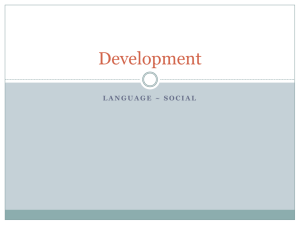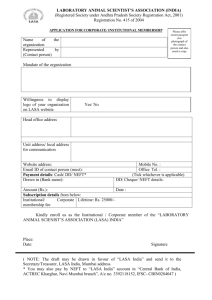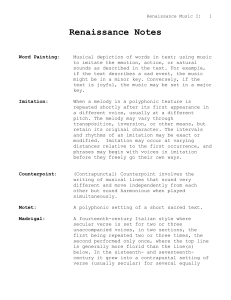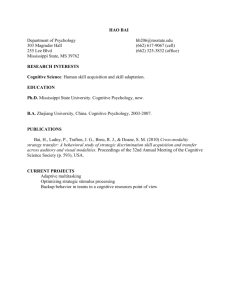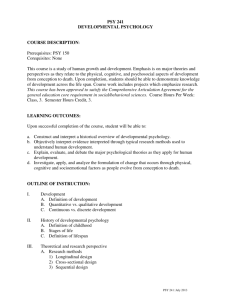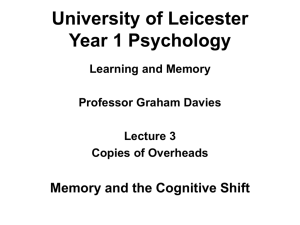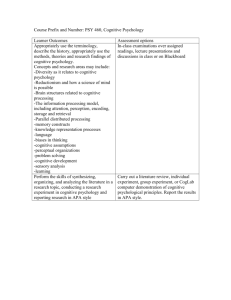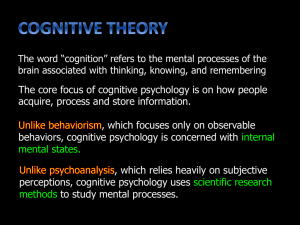Imitation Learning for Robots - Yale School of Engineering
advertisement
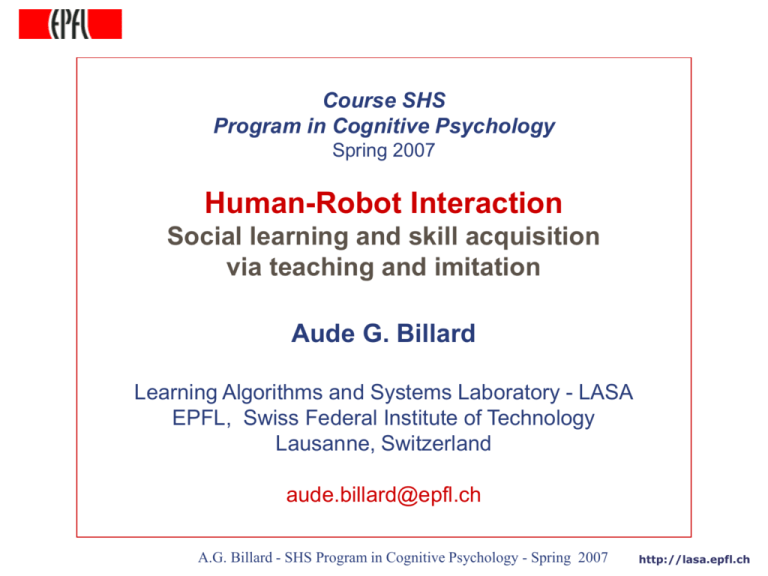
Course SHS Program in Cognitive Psychology Spring 2007 Human-Robot Interaction Social learning and skill acquisition via teaching and imitation Aude G. Billard Learning Algorithms and Systems Laboratory - LASA EPFL, Swiss Federal Institute of Technology Lausanne, Switzerland aude.billard@epfl.ch A.G. Billard - SHS Program in Cognitive Psychology - Spring 2007 http://lasa.epfl.ch Calinon, S. and Billard, A. (2007) Gestures by Imitation in a2007 Humanoid Robot. in A.G. Incremental Billard - SHS Learning Program inof Cognitive Psychology - Spring http://lasa.epfl.ch Proceedings of the ACM/IEEE International Conference on Human-Robot Interaction (HRI). Gesture Recognition How are actions perceived? How is information parsed? Imitation Level of granularity: What is copied? Should it copy the intention, goal or dynamics of movement? Motor Learning How is information transferred across multiple modalities? Visuo-motor, Auditor-motor A.G. Billard - SHS Program in Cognitive Psychology - Spring 2007 http://lasa.epfl.ch Gesture Recognition Biological Inspiration Learning by Imitation Robotic Implementation Motor Learning A.G. Billard - SHS Program in Cognitive Psychology - Spring 2007 http://lasa.epfl.ch BIOLOGICAL INSPIRATION Prior to building any capability in robots, we might want to understand how the equivalent capability works in humans and other animals A.G. Billard - SHS Program in Cognitive Psychology - Spring 2007 http://lasa.epfl.ch Imitation Learning Imitation Capabilities in Animals Which species may exhibit imitation is still a main Gesturearea Recognition of discussion and debate Biological Inspiration One differentiate “true” imitation from copying (flocking, schooling, following), stimulus enhancement, contagion or emulation Learning by Imitation A.G. Billard - SHS Program in Cognitive Psychology - Spring 2007 http://lasa.epfl.ch Imitation Learning Imitation Capabilities in Animals • Copying and Mimicry: Rats, Monkeys Gesture Recognition • Observe companion actor rats performing different spatial tasks differing according to the experimental requirements. After the observational training, surgical ablation to block any further learning Biological Inspiration Learning by Imitation • Legio et al, Brain Res. Protocols, 2003 • Heyes, Trends in Cog. Sciences, 2001 A.G. Billard - SHS Program in Cognitive Psychology - Spring 2007 http://lasa.epfl.ch Imitation Learning Imitation Capabilities in Animals • The observer rats displayed exploration abilities Gesture Recognition that closely matched the previously observed behaviors. Biological Inspiration Learning by Imitation • Legio et al, Brain Res. Protocols, 2003 • Heyes, Trends in Cog. Sciences, 2001 A.G. Billard - SHS Program in Cognitive Psychology - Spring 2007 http://lasa.epfl.ch Imitation Learning Imitation Capabilities in Monkeys Gesture Recognition Subjects who saw the Lever demonstrations tended to use a levering movement to pop open the lid whereas subjects who viewed Poke, as well as the controls, did not display this behavior at all. Biological Inspiration Learning by Imitation • Whiten et al, Journal of Comparative Psychology, 1996 A.G. Billard - SHS Program in Cognitive Psychology - Spring 2007 http://lasa.epfl.ch Imitation Learning Imitation Capabilities in Animals • “True” imitation: Ability to learn new actions not part Gesture Recognition of the usual repertoire • The appanage of humans only, and possibly great apes Biological Inspiration Learning by Imitation • Whiten & Ham, Advances in the Study of Behaviour, 1992 • Savage & Rumbaugh, Child Devel, 1993 A.G. Billard - SHS Program in Cognitive Psychology - Spring 2007 http://lasa.epfl.ch Imitation Learning Imitation Capabilities in Animals • Complex Imitation capabilities in Dolphins & Gesture Recognition Parrots. Large repertoire of imitation capabilities, demonstrating flexibility and generalization in different contexts. Biological Inspiration Learning by Imitation • Moore, Behaviour, 1999. • Herman, Imitation in Animals & Artifacts, MIT Press, 2002 A.G. Billard - SHS Program in Cognitive Psychology - Spring 2007 http://lasa.epfl.ch Imitation Learning Developmental Stages of Imitation • Innate Facial Imitation (newborns 3 months) Gesture Recognition Tongue and lips protrusion, mouth-opening, head movements, cheek and brow motion, eye blinking • Delayed imitation up to 24 hours Imitation is mediated by a stored representation Biological Inspiration Learning by Imitation Meltzoff & Moore, Early Development and Parenting, 1997 Meltzoff & Moore, Developmental Psychology, 1989 A.G. Billard - SHS Program in Cognitive Psychology - Spring 2007 http://lasa.epfl.ch Imitation Learning Developmental Stages of Imitation • Deferred and delayed imitation - 18 month (Piaget), 9Gesture Recognition 12 months (Meltzoff) • Deferred imitation of novel behavior Biological Inspiration 67% of the infants who saw the display reproduced the act after the week's delay, as compared to 0% of the control infants who had not seen the novel display. Learning by Imitation • Piaget, Play, Dreams and Imitation in Infancy, 1962 ; • Meltzoff, Body and the self, 1995 A.G. Billard - SHS Program in Cognitive Psychology - Spring 2007 http://lasa.epfl.ch Imitation Learning Goals and Intentions • Infants aged 14 months. Gesture Recognition • Children imitate new action to achieve the same goal only if they consider it to be the most rational alternative. Biological Inspiration Learning by Imitation •Gergely, Bekkering, Giraly, Nature 415, 755, 2002 A.G. Billard - SHS Program in Cognitive Psychology - Spring 2007 http://lasa.epfl.ch Imitation Learning Goals and Intentions • 18-months infants Gesture Recognition • Differentiate between human and machine demonstration Attribute intentions only to the human Biological Inspiration • Learn from unsuccessful examples Learning by Imitation • Meltzoff, Dev. Psychol. 31, 1995. A.G. Billard - SHS Program in Cognitive Psychology - Spring 2007 http://lasa.epfl.ch Imitation Learning Goals and Intentions • Imitation is hierarchical and goal-directed Gesture Recognition • Single-hand motions: accurate ipsilateral imitation, 48% subsitution for crosslateral imitation • Two-hand motions: only 10% substitution for crosslateral imitation. Biological Inspiration Learning by Imitation • Two-phase motion eliminates mistakes • Adding constraints of hand gestures increases mistakes • Bekkering, Wolschlager & Gattis, Quart. J. of Exp. Psych, 2000 A.G. Billard - SHS Program in Cognitive Psychology - Spring 2007 http://lasa.epfl.ch Imitation Learning Imitation in adults • Reaches highest level of complexity Gesture Recognition • Is present in all activities: Social influence in establishing group norms; collective frame of reference, transmission of phoebias Biological Inspiration Learning by Imitation A.G. Billard - SHS Program in Cognitive Psychology - Spring 2007 http://lasa.epfl.ch Imitation Learning Imitation Capabilities in Adults Movement observation influences movement execution Gesture Recognition Priming process occurs involuntarily and is not under the actor’s control. Biological Inspiration Learning by Imitation • Brass, Bekkering, Prinz, Acta Psychologia, 2001 A.G. Billard - SHS Program in Cognitive Psychology - Spring 2007 http://lasa.epfl.ch Imitation Learning Neural Correlates • Mirror Neuron System – F5 Area of Monkey M1 Gesture Recognition Biological Inspiration Learning by Imitation • Gallese et al, Brain, 1996. ; Rizzolatti et al, Cog. Brain Res., 1996 A.G. Billard - SHS Program in Cognitive Psychology - Spring 2007 http://lasa.epfl.ch Imitation Learning Neural Correlates • Mirror Neuron System – locus of visuo-motor Gesture Recognition transformation (STS, PM, Broca) Biological Inspiration Learning by Imitation • Iacoboni et al, Science 1999 • Arbib, Billard, Iacoboni, Oztop, Neural Networks, 2000. A.G. Billard - SHS Program in Cognitive Psychology - Spring 2007 http://lasa.epfl.ch Imitation Learning in Animals Take-Home Message • Range of imitative behaviors in animals Increasing in complexity across species • Stages of development in children imitation innate facial imitation inferring goals hierarchy of goals driving imitation (hand motion takes precedence over arm gesture and location in space) • Imitation in adulthood is influenced by mvmt observation, handedness, orientation of the demonstrator • The underlying neural mechanisms are not yet completely deciphered A better understanding of those would help shed light on the different levels of imitation in animal behavior A.G. Billard - SHS Program in Cognitive Psychology - Spring 2007 http://lasa.epfl.ch Imitation Learning in Animals Take-Home Message Advantages: When is Imitation useful? • It is a powerful means of transferring skills • It speeds up the learning process by showing possible solutions or conversely by showing bad solutions A.G. Billard - SHS Program in Cognitive Psychology - Spring 2007 http://lasa.epfl.ch Imitation Learning in Animals Take-Home Message Disadvantages: When is Imitation not useful? • Not appropriate: When a good solution for the teacher is not a possible solution for the learner • Disadvantageous: When it induces you in error bad teacher (e.g. phoebia of spiders) A.G. Billard - SHS Program in Cognitive Psychology - Spring 2007 http://lasa.epfl.ch Gesture Recognition Biological Inspiration Learning by Imitation Robotic Implementation Motor Learning A.G. Billard - SHS Program in Cognitive Psychology - Spring 2007 http://lasa.epfl.ch The Transfer Problem Imitator Demonstrator , , 1 2 4 , , 5 6 ? 3 , , 1 3 4 x x1 , x2 , x3 , , 5 6 x x1, x2 , x3 7 7 A.G. Billard - SHS Program in Cognitive Psychology - Spring 2007 http://lasa.epfl.ch What to imitate? x x d d v v Same Object, same target location Same direction of motion Same speed, same force Same posture , , , , 1 2 1 3 4 , , 5 6 7 v x x1 , x2 , x3 d 2 3 x x1, x2 , x3 d 4 , , 5 6 7 v A.G. Billard - SHS Program in Cognitive Psychology - Spring 2007 http://lasa.epfl.ch How to Imitate? The correspondence problem Demonstration Imitation ? No solutions (smaller range of motion) Find the closest solution according to a metric A.G. Billard - SHS Program in Cognitive Psychology - Spring 2007 http://lasa.epfl.ch Imitation Learning Following – an imitation mechanism • While following the teacher, the learner robot learns to Gesture Recognition associate a word with a meaning in terms of sensory inputs Learning by Imitation Robotic Implementation • Billard et al, ESANN’1997, • Billard & Dautenhahn, Robotics & Autonomous Systems 1998, • Billard & Hayes, 99,00 A.G. Billard - SHS Program in Cognitive Psychology - Spring 2007 http://lasa.epfl.ch Imitation Learning Following – an imitation mechanism •Teaching path in a Maze Gesture Recognition Demiris & Hayes, 1994, 1996; • Teaching how to climb a hill Dautenhahn, Robotics & Autonomous Systems, 1995 Learning by Imitation • Teaching a path in the environment Robotic Implementation Billard & Hayes, Adaptive Behavior, 1999 Moga, Gaussier, Applied Artificial Intelligence, 2000 Kaiser et al, Robotics & Autonomous Systems, 2002 Nicolescu & Mataric, AGENTS’ 2003 • Teaching a vocabulary Billard 1997, 1998, 1999 Vogt & Steels, ECAL, 1999 A.G. Billard - SHS Program in Cognitive Psychology - Spring 2007 http://lasa.epfl.ch Imitation Learning One-Shot Learning Methods • Segmentation of demonstration into primitives Gesture Recognition • Classification of gestures into predefined states (e.g. grasp, collision) • Built-in controller for producing sequences of states Learning by Imitation Robotic Implementation • Kuniyoshi et al. IEEE Trans. on Robotics and Automation,1994. • Dillmann et al, Robotics & Autonomous Systems, 2001. • Ritter et al, Rev Neuroscience, 2003 • Aleotti et al, Robotics & Autonomous Systems, 2004. A.G. Billard - SHS Program in Cognitive Psychology - Spring 2007 http://lasa.epfl.ch Robot Programming by Demonstration One-Shot Learning Methods Sensors: Data Gloves, Fixed cameras, Speech processing Actuators: Mobile robot, 7 DOF arm, 2 fingers Gripper R. Dillmann, Robotics & Autonomous Systems 47:2-3, 109-116, 2004 A.G. Billard - SHS Program in Cognitive Psychology - Spring 2007 http://lasa.epfl.ch Imitation Learning One-Shot Learning Methods Explicit teaching/learning: - Reasoning about tasks Gesture Recognition - Verbal instructions Gesture Recognition: For each sensor a context-dependent Learning by Imitation model based on background knowledge is provided: ‘opening the refrigerator door’, ‘extracting the bottle’ and ‘closing the door’ Robotic Implementation Task Reproduction: Store action sequences in a tree-like structure of macro-operators R. Dillmann, Robotics & Autonomous Systems 47:2-3, 109-116 2004 A.G. Billard - SHS Program in Cognitive Psychology - Spring 2007 http://lasa.epfl.ch Imitation Learning Robot Programming by Demonstration: Grasping Gesture Recognition Because of the large range of possible shapes, generalizing preprogrammed grasps to new and general objects is a rather hard task: Learning by Imitation • Orientation of the hand • Positioning of the fingers (correspondence problem!) • Tactile forces, stable object contact Robotic Implementation Steil et al, Robotics & Autonomous Systems 47:2-3, 129-141, 2004 A.G. Billard - SHS Program in Cognitive Psychology - Spring 2007 http://lasa.epfl.ch Imitation Learning Robot Programming by Demonstration: Grasping Gesture Recognition (i) a ‘naïve’ imitation strategy, in which the observed joint angle trajectories (after their transformation into the three-finger geometry) were directly applied to control the fingers Learning of the TUM hand during the grasp, until complete closure around the object by Imitation Robotic Implementation (ii) a strategy in which the visually observed hand posture is matched to the initial conditions of a power grip, a precision grip, a three-finger and twofinger grip, respectively, in order to identify the grip type. Steil et al, Robotics & Autonomous Systems 47:2-3, 129-141, 2004 A.G. Billard - SHS Program in Cognitive Psychology - Spring 2007 http://lasa.epfl.ch Robot Programming by Demonstration Other related works are, e.g.: • • • Kuniyoshi et al, ICRA, 1994 Aleotti et al, Robotics & Autonomous Systems, 47:2-3, 153-167, 2004 Zhang & Roessler, Robotics & Autonomous Systems 47:2-3, 117-127, 2004 A.G. Billard - SHS Program in Cognitive Psychology - Spring 2007 http://lasa.epfl.ch Imitation Learning Learning of Dynamical Systems • Learning the optimal controller Gesture Recognition • Model of physical system (pendulum) • Reinforcement and locally weighted learning Learning by Imitation Robotic Implementation • Atkeson & Schaal, ICML, 1997. A.G. Billard - SHS Program in Cognitive Psychology - Spring 2007 http://lasa.epfl.ch Imitation Learning Learning of Dynamical Systems • Locally weighted learning Gesture Recognition • Learning primitives of the system Learning by Imitation Robotic Implementation •Ijspeert, Nakanishi, Schaal, ICRA’01, NIPS’02 A.G. Billard - SHS Program in Cognitive Psychology - Spring 2007 http://lasa.epfl.ch Imitation Learning Learning of Dynamical Systems • Locally weighted learning Gesture Recognition • Learning primitives of the system Learning by Imitation Robotic Implementation •Ijspeert, Nakanishi, Schaal, ICRA’01, NIPS’02 A.G. Billard - SHS Program in Cognitive Psychology - Spring 2007 http://lasa.epfl.ch Imitation Learning Learning of Dynamical Systems The learned trajectory is not sufficient to control the Gesture Recognition actual robot’s walking pattern. Phase resetting using foot contact information is necessary. on-line adjustment of the phase of the CPG by sensory feedback from the environment is essential to Learning by Imitation achieve successful locomotion Robotic Implementation Nakanishi et al, Robotics & Autonomous Systems, 47:2-3, 79-91, 2004. A.G. Billard - SHS Program in Cognitive Psychology - Spring 2007 http://lasa.epfl.ch Imitation Learning in Robots Granularity Cognition How to imitate? Level 3: Learning primitives of motion Level 2: Exact reproduction of trajectories Level 1: One-shot learning Level 0: Following – an implicit imitation mechanism A.G. Billard - SHS Program in Cognitive Psychology - Spring 2007 http://lasa.epfl.ch IMITATION LEARNING VERSUS MOTOR LEARNING Imitation learning – Programming by Demonstration: • A way to speed up learning, to reduce the search space • A way to share with the robot’s the same vocabulary of motor skills Self Motor Learning - Reinforcement Learning • To adapt to novel situations • To adapt the demonstrated motions to the robot’s body Correspondence problem (Nehaniv & Dautenhahn 1999) A.G. Billard - SHS Program in Cognitive Psychology - Spring 2007 http://lasa.epfl.ch Learning What to imitate The robot should learn that the important feature in this task is that the queen should be moved 2 steps forward vertically A.G. Billard - SHS Program in Cognitive Psychology - Spring 2007 http://lasa.epfl.ch Learning How to Imitate Once the robot has learned the rule of motion for the queen, it can apply this rule for moving the queen from locations not seen during the demonstrations A.G. Billard - SHS Program in Cognitive Psychology - Spring 2007 http://lasa.epfl.ch IMITATION LEARNING VERSUS MOTOR LEARNING Imitation learning – Programming by Demonstration: • A way to speed up learning, to reduce the search space • A way to share with the robot’s the same vocabulary of motor skills Self Motor Learning - Reinforcement Learning • To adapt to novel situations • To adapt the demonstrated motions to the robot’s body Correspondence problem (Nehaniv & Dautenhahn 1999) A.G. Billard - SHS Program in Cognitive Psychology - Spring 2007 http://lasa.epfl.ch Transmitting human skills and knowledge to robots Learning a Packaging Task A.G. Billard - SHS Program in Cognitive Psychology - Spring 2007 http://lasa.epfl.ch From Recognizing to Reproducing Gestures A.G. Billard - SHS Program in Cognitive Psychology - Spring 2007 http://lasa.epfl.ch From Recognizing to Reproducing Gestures GMM/HMM Encoding: Recovers generalized signal by regression Mixture of k Gaussians A.G. Billard - SHS Program in Cognitive Psychology - Spring 2007 http://lasa.epfl.ch Learning What to imitate? Tracking of object – stereovision Tracking of joint trajectories GMM over 26 demonstrations 3D velocities of the end effector Calion, S., Guenter, F. andA.G. Billard, A. - (2007) On Learning, and Generalizing a Task in a Billard SHS Program in CognitiveRepresenting Psychology - Spring 2007 http://lasa.epfl.ch Humanoid Robot. IEEE Transactions on Systems, Man and Cybernetics, 37:2. Part B. Special issue on robot Learning What to imitate? Calion, S., Guenter, F. and Billard, A. (2007) On Learning, Representing and Generalizing a Task in a Humanoid Robot. IEEE Transactions on Systems, Man and Cybernetics, 37:2. Part B. Special issue on robot A.G. Billard - SHS Program in Cognitive Psychology - Spring 2007 http://lasa.epfl.ch learning by observation, demonstration and imitation. Learning What to imitate? Correlations in the latent space of the two hands Hands-Bucket Correlations A.G. Billard - SHS Program in Cognitive Psychology - Spring 2007 http://lasa.epfl.ch IMITATION LEARNING VERSUS MOTOR LEARNING Imitation learning – Programming by Demonstration: • A way to speed up learning, to reduce the search space • A way to share with the robot’s the same vocabulary of motor skills Self Motor Learning - Reinforcement Learning • To adapt to novel situations • To adapt the demonstrated motions to the robot’s body Correspondence problem (Nehaniv & Dautenhahn 1999) A.G. Billard - SHS Program in Cognitive Psychology - Spring 2007 http://lasa.epfl.ch IMITATION LEARNING VERSUS MOTOR LEARNING Imitation learning – Programming by Demonstration: • A way to speed up learning, to reduce the search space • A way to share with the robot’s the same vocabulary of motor skills Self Motor Learning - Reinforcement Learning • To adapt to novel situations • To adapt the demonstrated motions to the robot’s body Correspondence problem (Nehaniv & Dautenhahn 1999) A.G. Billard - SHS Program in Cognitive Psychology - Spring 2007 http://lasa.epfl.ch Computing the Metric of Imitation Performance Hands’ Paths Joints Trajectories A.G. Billard - SHS Program in Cognitive Psychology - Spring 2007 http://lasa.epfl.ch Adapting the Demonstration to Fit the Robot’s Body Minimizing H Under the kinematics constraint: By Lagrange, we compute the optimal solution: A.G. Billard - SHS Program in Cognitive Psychology - Spring 2007 http://lasa.epfl.ch Adapting the Demonstration to Fit the Robot’s Body Minimizing H Under the kinematics constraint: By Lagrange, we compute the optimal solution: A.G. Billard - SHS Program in Cognitive Psychology - Spring 2007 http://lasa.epfl.ch Adapting the Demonstration to Fit the Robot’s Body A.G. Billard - SHS Program in Cognitive Psychology - Spring 2007 http://lasa.epfl.ch 1st Limitation of the System A.G. Billard - SHS Program in Cognitive Psychology - Spring 2007 http://lasa.epfl.ch 1st Limitation of the System Misses the bucket A.G. Billard - SHS Program in Cognitive Psychology - Spring 2007 http://lasa.epfl.ch IMITATION LEARNING VERSUS MOTOR LEARNING Imitation learning – Programming by Demonstration: • A way to speed up learning, to reduce the search space • A way to share with the robot’s the same vocabulary of motor skills Self Motor Learning - Reinforcement Learning • To adapt to novel situations • To adapt the demonstrated motions to the robot’s body Correspondence problem (Nehaniv & Dautenhahn 1999) A.G. Billard - SHS Program in Cognitive Psychology - Spring 2007 http://lasa.epfl.ch Dynamic Adaptation of Gesture Reproduction Dynamical system modulation to be robust to perturbations (novel context, obstacles, etc) A.G. Billard - SHS Program in Cognitive Psychology - Spring 2007 http://lasa.epfl.ch Dynamical System Modulation Different initial conditions Adaptation to sudden target displacement A.G. Billard - SHS Program in Cognitive Psychology - Spring 2007 http://lasa.epfl.ch Different initial conditions Adaptation to sudden target displacement A.G. Billard - SHS Program in Cognitive Psychology - Spring 2007 http://lasa.epfl.ch Dynamic Adaptation of Gesture Reproduction Adaptation to different contexts Online adaptation to changes in the context Hersch, M., Guenter, F., Calinon, S. and Learning Dynamical Systemhttp://lasa.epfl.ch Modulation for A.G. Billard - SHSBillard, ProgramA.in (2006) Cognitive Psychology - Spring 2007 Constrained Reaching Tasks. In Proceedings of the IEEE-RAS International Conference on Humanoid Robots. 2nd Limitation of the System If the novel situation differs Importantly from the demonstrated one, then adapting the demonstrated trajectory is no longer sufficient to satisfy the task. A.G. Billard - SHS Program in Cognitive Psychology - Spring 2007 http://lasa.epfl.ch 2nd Limitation of the System If the novel situation differs Importantly from the demonstrated one, then adapting the demonstrated trajectory is no longer sufficient to satisfy the task. Need to relearn the task -- Reinforcement Learning Need to define a new metric – the reward A.G. Billard - SHS Program in Cognitive Psychology - Spring 2007 http://lasa.epfl.ch RL - To Adapt to Novel Situations Reinforcement Learning episodic Natural Actor Critic (NAC) is applied to learn a new trajectory, so as to overcome the obstacle. Gaussian Stochastic Policy A.G. Billard - SHS Program in Cognitive Psychology - Spring 2007 http://lasa.epfl.ch RL - To Adapt to Novel Situations The robot is rewarded for reaching the obstacle, as well as staying close to the original demonstrated trajectory. A.G. Billard - SHS Program in Cognitive Psychology - Spring 2007 http://lasa.epfl.ch RL - To Adapt to Novel Situations A.G. Billard - SHS Program in Cognitive Psychology - Spring 2007 http://lasa.epfl.ch RL - To Adapt to Novel Situations In each case, at least 1 run fails to find a solution Need to run the algorithm several times Time consumingA.G. Billard - SHS Program in Cognitive Psychology - Spring 2007 http://lasa.epfl.ch INCREMENTAL LEARNING The robot records the position of the objects, the position of the teacher's hands, the joint angles of the teacher's upper-body motion (motion sensors) A.G. Billard -of SHS Program in Cognitive Psychology - Spring(kinesthetics). 2007 http://lasa.epfl.ch or/and the joint angles the robot's upper-body motion INCREMENTAL LEARNING Movie A.G. Billard - SHS Program in Cognitive Psychology - Spring 2007 http://lasa.epfl.ch INCREMENTAL LEARNING Movie 6 demonstrations of moving the white Knight to catch the black King A.G. Billard - SHS Program in Cognitive Psychology - Spring 2007 http://lasa.epfl.ch INCREMENTAL LEARNING Movie Trajectories of the hand with respect to the first and second object. (Left) Superimposed, the trajectories of each of the 6 demonstrations Middle: Gaussian Mixture Model, Right, Gaussian Mixture Regression A.G. Billard - SHS Program in Cognitive Psychology - Spring 2007 http://lasa.epfl.ch INCREMENTAL LEARNING A.G. Billard - SHS Program in Cognitive Psychology - Spring 2007 http://lasa.epfl.ch INCREMENTAL LEARNING A.G. Billard - SHS Program in Cognitive Psychology - Spring 2007 http://lasa.epfl.ch INCREMENTAL LEARNING Movie A.G. Billard - SHS Program in Cognitive Psychology - Spring 2007 http://lasa.epfl.ch SUMMARY Learning new tasks relies on various means of teaching the robots. Imitation learning is useful in so far that it gives hints as to the optimal solution The robot must however rely on generic skills of its own to adapt the demonstration to its own body and to the context Learning of complex skills is overall relatively slow and must proceed incrementally A.G. Billard - SHS Program in Cognitive Psychology - Spring 2007 http://lasa.epfl.ch
